
The Thomas Alva Edison Birthplace is a historic house museum at 9 Edison Drive in Milan, Ohio, Built in 1841, it was the birthplace of American inventor Thomas Alva Edison (1847-1931) was born on February 11, 1847. It was designated a National Historic Landmark in 1965, and was added to the National Register of Historic Places in 1966. It is now the Thomas Edison Birthplace Museum.

TheWar Memorial, also known as the Russell A. Alger Jr. House and as the Moorings was dedicated to the memory of veterans and soldiers of World War II. It is located at 32 Lake Shore Drive in Grosse Pointe Farms, MI.

The Albert Kahn House is located at 208 Mack Avenue in Midtown Detroit, Michigan, within the Brush Park district. It is currently the headquarters of the Detroit Urban League. The house was designated a Michigan State Historic Site in 1971 and listed on the National Register of Historic Places in 1972.
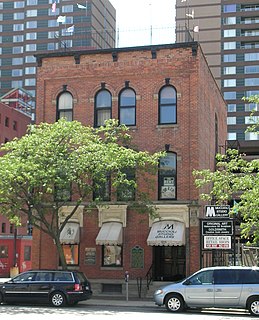
The Alexander Chapoton House is a Queen Anne style row house located at 511 Beaubien Street in Downtown Detroit, Michigan. It was listed on the National Register of Historic Places and designated a Michigan State Historic Site in 1980.

The Croul–Palms House is a private residence located at 1394 East Jefferson Avenue in Detroit, Michigan. The house is named after its first two owners, Jerome Croul and Francis Palms. It was listed on the National Register of Historic Places in 1983.

Ottawa Street Power Station is a former municipal electric and steam utility generating station for the Lansing Board of Water and Light in Lansing, Michigan, located on the Grand River in the city's central business district that was redeveloped as corporate headquarters for the Accident Fund Insurance Company of America.
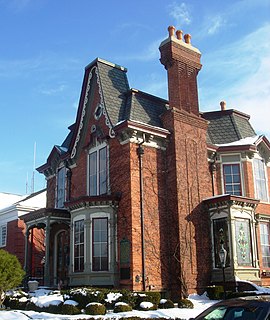
The Henry W. Baker House is located at 233 S. Main St. in Plymouth, Michigan. It was built as a private home, but now houses commercial space. It was designated a Michigan State Historic Site in 1981 and listed on the National Register of Historic Places in 1982.
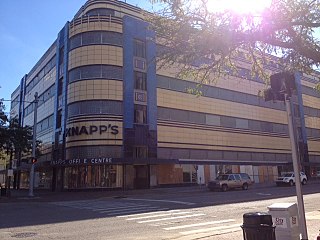
The J.W. Knapp Company Building is a historic five-story, 190,000-square-foot (18,000 m2) Streamline Moderne building in Lansing, Michigan, United States. Designed by Orlie Munson of the Bowd–Munson Company, which also designed several other Art Deco landmarks in Lansing, including the Ottawa Street Power Station, it was constructed by the Christman Company in 1937 through 1938. The curvilinear look of the streamlined structure comes from huge plates of concrete faced with enamel, called "Maul Macotta", a copyrighted product of the Maul Macotta Company and prismatic glass brick windows. Alternating horizontal bands of yellow macotta and glass block are interrupted by vertical blue macotta pylons, rising from the building's four principal entrances. The pylons are pierced by windows. The entrance portals, display window aprons, and decorative banding are dark blue macotta. Red, yellow and blue spandrels, incorporating the letter "K" as a design element, decorate the entrance portals.

The Dodge Mansion, also known as Turner-Dodge House, is a historic house in Lansing, Michigan that was built in 1855. It was listed on the National Register of Historic Places (NRHP) in 1972 as Dodge Mansion.

The Smith–Turner House is an Italianate and Queen Anne-styled house located at 326 West Grand River Avenue in Lansing, Michigan. It was listed on the National Register of Historic Places in 1980.

The John Armstrong House is a private residential structure located at 707 Monroe Street in the city of Lapeer in Lapeer County, Michigan. It was designated as a Michigan State Historic Site and also added to the National Register of Historic Places on July 26, 1985.
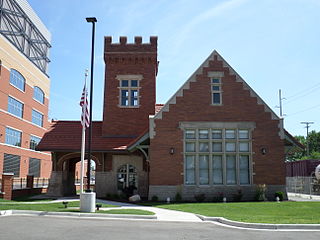
The Grand Trunk Western station was a historic railroad station in Lansing, Michigan. The station was listed as a Michigan State Historic Site in 1978, and it was added to the National Register of Historic Places in 1980.

The Charles Palmer House is a single-family home located at 240 North Main Street in Imlay City, Michigan. It was listed on the National Register of Historic Places in 1987.

The William H. Davenport House, also known as the Davenport-Curtis House, is a single-family home located at 300 East Michigan Avenue in Saline, Michigan. It was listed on the National Register of Historic Places in 1975.

The Thomas Earl House was built as a single-family home located at 415 North Main Street in Ann Arbor, Michigan. It was listed on the National Register of Historic Places in 1992. The house has been renovated to office space.

The Benjamin Davis House was a historic house located at 528 South Washington Avenue Lansing, Michigan. It was formerly listed on the National Register of Historic Places, but was demolished and delisted in 1972.

The Brown-Price House is a former single-family home located at 1003 North Washington Avenue in Lansing, Michigan. It was listed on the National Register of Historic Places in 1984. As of 2018, it was used as offices for a law firm.

The Marshall Street Armory is a former armory for the Michigan National Guard. It was listed on the National Register of Historic Places in 2010.
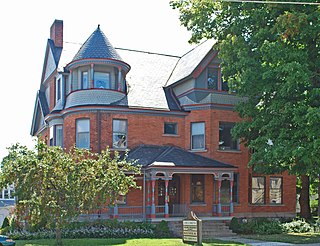
The Hugh H. Richard House, also known as the Hand Building, was built as a single-family home, and later converted to office use. It is located at 505 Wildwood Avenue in Jackson, Michigan. It was listed on the National Register of Historic Places in 1993.

Oakhill, also known as the Chauncey M. Brewer House, is a single-family home located at 410 North Eagle Street in Marshall, Michigan. It was listed on the National Register of Historic Places in 1974.




























